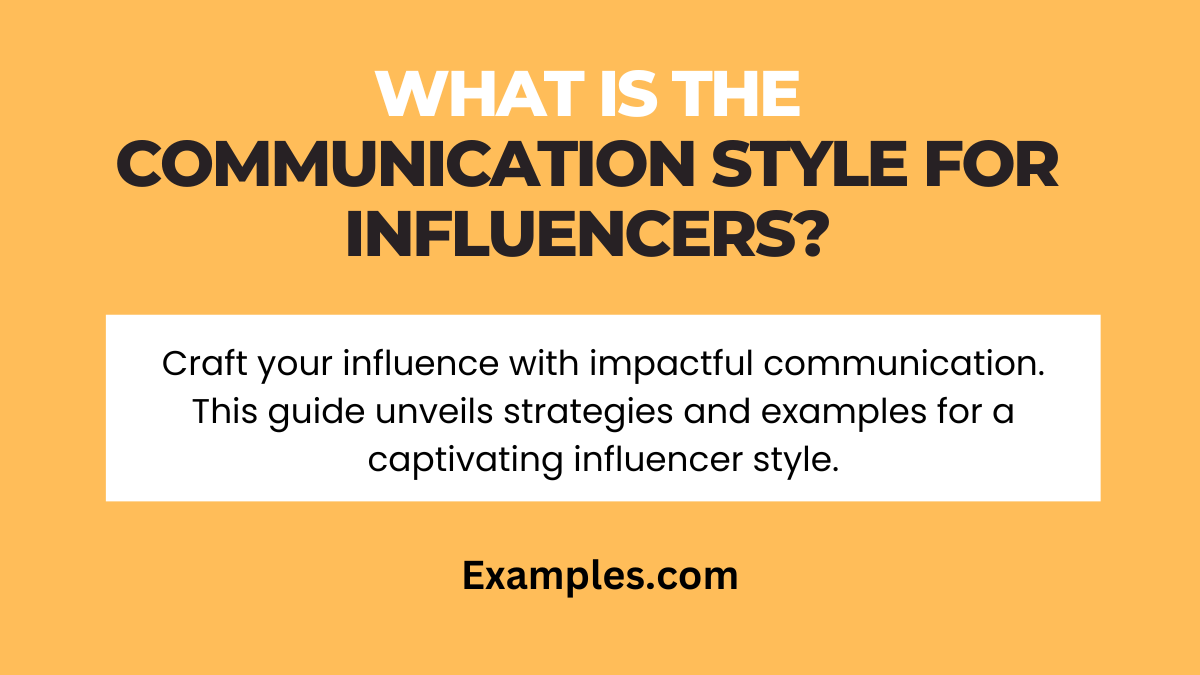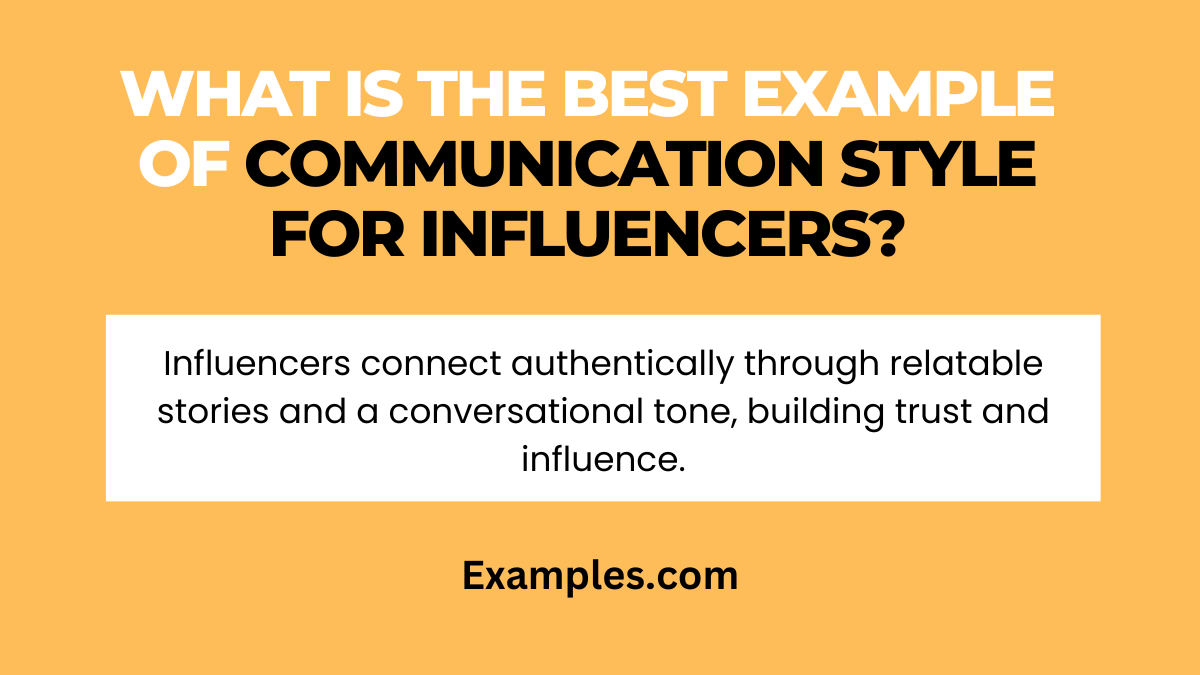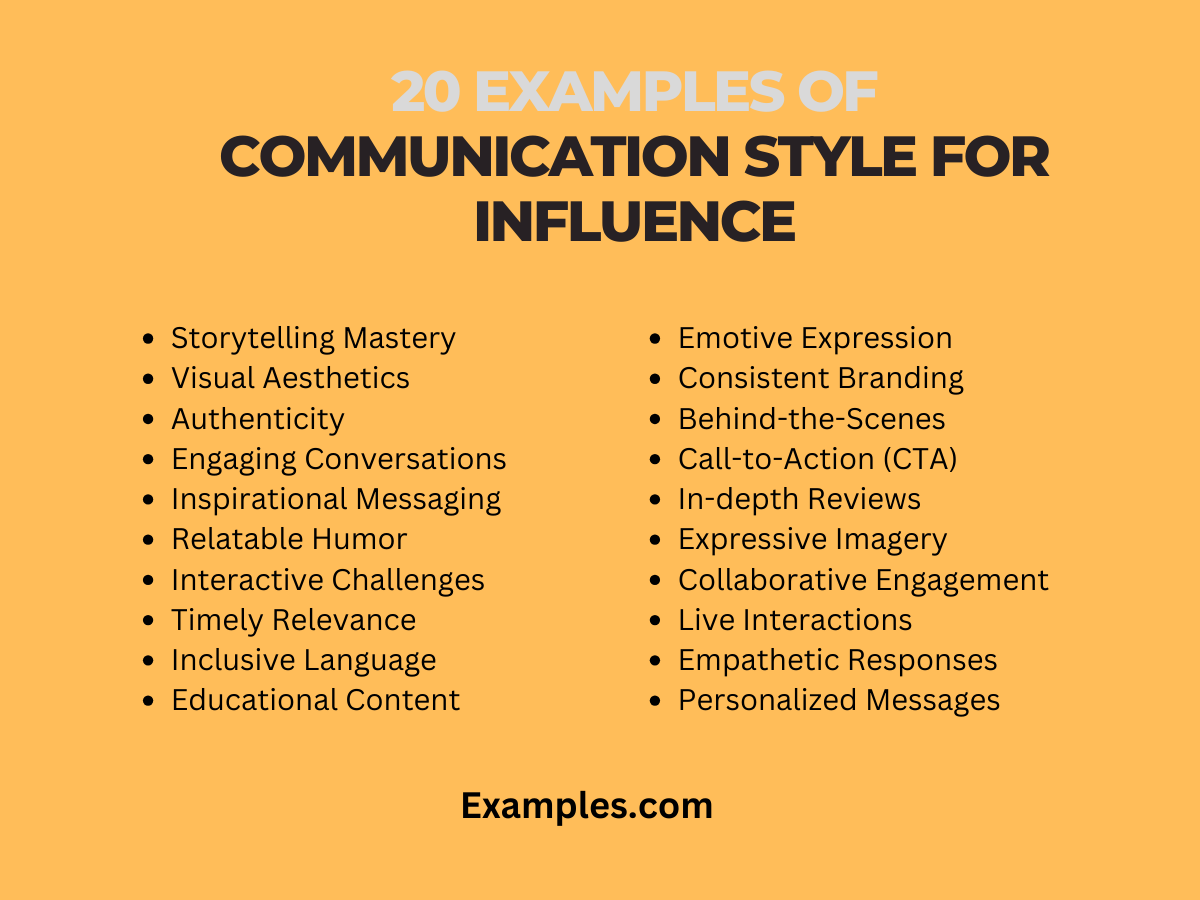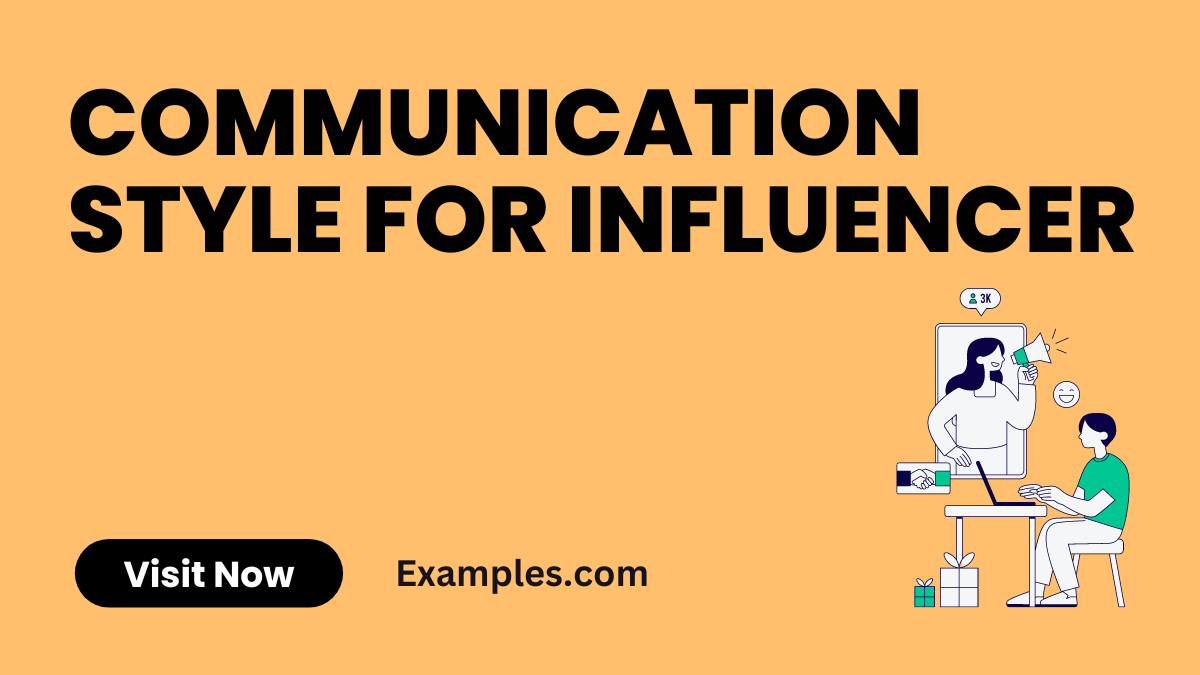19+ Communication Style for Influencer Examples
Unleash the potential of your influence by mastering a dynamic Communication Style for Influencer. This comprehensive guide empowers you with proven strategies and real-world examples to refine your communication prowess. Explore the nuances of effective expression, leverage impactful storytelling, and discover tailored communication examples that resonate with your audience. Elevate your influence to new heights by honing a captivating communication style tailored for success.
What is the Communication Style for Influencers?

In the realm of influencer dynamics, “Communication Style for Influencer” encompasses the distinctive mannerisms and strategies influencers employ to convey messages effectively. This H2 heading illuminates the significance of a refined communication approach tailored to captivate and engage audiences, essential for success in the influencer sphere.
What is the best Example of Communication Style for Influencers?

Influencers excel in authentic communication, such as sharing personal stories or experiences. This genuine approach resonates with followers, fostering trust and connection. By showcasing relatable content and using a conversational tone, influencers create a unique communication style that captivates and influences their audience effectively.
20 Examples of Communication Style for Influence

- Storytelling Mastery: Influencers excel in weaving captivating narratives, engaging audiences through compelling stories.
- Visual Aesthetics: Effective influencers curate visually appealing content, utilizing aesthetics to enhance communication.
- Authenticity: Genuine self-expression builds trust, with influencers sharing authentic moments and experiences.
- Engaging Conversations: Influencers actively engage with followers, fostering two-way communication for a sense of community.
- Inspirational Messaging: Communicating aspirational messages motivates and inspires followers.
- Relatable Humor: Humorous content creates a relatable and enjoyable communication style.
- Interactive Challenges: Influencers often initiate interactive challenges, encouraging participation and engagement.
- Timely Relevance: Staying relevant to current trends ensures influencers connect with their audience’s interests.
- Inclusive Language: Using inclusive language helps influencers connect with diverse audiences.
- Educational Content: Sharing knowledge or tips showcases expertise, enriching followers’ experience.
- Emotive Expression: Expressing emotions authentically fosters deeper connections with followers.
- Consistent Branding: Influencers maintain a consistent visual and messaging brand for recognizable communication.
- Behind-the-Scenes: Providing glimpses into personal or professional life enhances relatability.
- Call-to-Action (CTA): Influencers employ compelling CTAs to prompt specific responses from their audience.
- In-depth Reviews: Influencers offer detailed reviews, providing valuable insights to their followers.
- Expressive Imagery: Strategic use of expressive images enhances communication impact.
- Collaborative Engagement: Partnering with followers or other influencers creates a sense of community.
- Live Interactions: Real-time engagement through live sessions establishes immediate and authentic communication.
- Empathetic Responses: Influencers show empathy by responding to followers’ comments or concerns.
- Personalized Messages: Addressing followers personally adds a touch of intimacy to communication.
How do you communicate with influence?
Influencers master the art of impactful communication, engaging audiences and fostering connection. Here’s a comprehensive guide on how to communicate with influence:
- Authenticity as a Foundation:
- Establish trust through genuine self-expression.
- Share personal experiences to create relatable content.
- Visual Storytelling Techniques:
- Curate visually appealing content for a strong visual identity.
- Use images and videos to narrate compelling stories.
- Engagement Strategies for Connection:
- Foster two-way communication by actively responding to followers.
- Initiate interactive challenges to encourage participation.
- Building an Aspirational Persona:
- Communicate aspirational messages that inspire and motivate.
- Showcase personal growth and achievements.
- Utilizing Relatable Humor:
- Infuse humor into content for a relatable and enjoyable experience.
- Understand the audience’s sense of humor for better connection.
- Incorporating Educational Elements:
- Share knowledge, tips, or tutorials to showcase expertise.
- Provide value through informative and educational content.
- Adapting to Trends and Relevance:
- Stay current with trends to remain relevant.
- Create content that resonates with the audience’s interests.
- Consistent Branding Across Platforms:
- Maintain a cohesive visual and messaging brand for recognition.
- Reinforce brand identity through consistent elements.
- Creating Personal Connections:
- Offer glimpses into personal life for a more intimate connection.
- Share behind-the-scenes content to humanize the influencer.
- Strategic Use of Call-to-Action (CTA):
- Encourage specific responses from followers through compelling CTAs.
- Guide followers to take desired actions or engage with content.
By implementing these strategies, influencers can refine their communication style, leaving a lasting impact on their audience and building a loyal community.
How would you describe their style of communication and its effectiveness?
- Authenticity: Influencers prioritize genuine and transparent communication.
- Visual Storytelling: Utilizing compelling visuals to convey messages effectively.
- Interactive Engagement: Actively engaging with the audience through comments, polls, and Q&A sessions.
- Community Building: Fostering a sense of belonging and community among followers.
- Humor Integration: Incorporating humor to make content entertaining and relatable.
- Educational Content: Providing valuable information to educate and engage the audience.
- Aspirational Elements: Including aspirational aspects to inspire and motivate followers.
- Active Audience Participation: Encouraging followers to actively participate in discussions and activities.
- Consistent Branding: Maintaining a consistent brand image across platforms and content.
- Personalized Communication: Tailoring messages to resonate with the specific interests and preferences of the audience.
Which is the easiest method of communication and why?
- Face-to-Face Communication:
- Allows for immediate feedback.
- Incorporates non-verbal cues.
- Facilitates a natural flow of conversation.
- Texting:
- Quick and convenient for straightforward messages.
- Supports asynchronous communication.
- Suitable for brief exchanges.
- Email:
- Provides a written record of communication.
- Allows for detailed and formal communication.
- Convenient for conveying information at a distance.
- Phone Calls:
- Enables real-time conversation.
- Allows for tone of voice interpretation.
- Suitable for more complex discussions.
- Video Calls:
- Combines visual and auditory communication.
- Mimics face-to-face interaction remotely.
- Enhances the personal touch of communication.
- Instant Messaging:
- Supports real-time, quick exchanges.
- Facilitates group communication.
- Convenient for informal conversations.
- Written Notes:
- Simple and direct for one-way communication.
- Useful for leaving messages or reminders.
- Physical notes may be tangible and memorable.
- Social Media Messaging:
- Combines written and multimedia elements.
- Facilitates communication on popular platforms.
- Supports casual and frequent interactions.
- Collaboration Platforms:
- Facilitates communication within teams.
- Integrates various communication tools.
- Streamlines project-related discussions.
- Non-Verbal Communication:
- Relies on gestures, body language, and facial expressions.
- Effective for conveying emotions and attitudes.
- Often used in conjunction with other communication methods.
The choice of the easiest method depends on the specific communication needs, the nature of the message, and personal preferences of the individuals involved.
What is the most powerful method of communication?
- Public Speaking: Considered powerful for its ability to influence and engage large audiences.
- Verbal Eloquence: Effectively articulating thoughts and ideas with clarity and persuasiveness.
- Body Language: Non-verbal cues enhance communication, conveying confidence and authority.
- Effective Storytelling: Engaging narratives capture attention and leave a lasting impact.
- Passionate Delivery: Expressing emotions and enthusiasm adds depth to the message.
- Authority: Conveying expertise and knowledge enhances the credibility of the communication.
- Adaptability: Tailoring communication style to suit different audiences and situations.
- Persuasion: Skillful use of language and arguments to influence opinions and decisions.
- Clarity: Clearly conveying ideas ensures understanding and retention.
- Engagement: Interactive elements keep the audience involved and connected.
Unveil the art of influential communication with this comprehensive guide on communication style for influencers. Dive into real-world examples to decipher effective strategies, captivating narratives, and powerful delivery techniques. Elevate your influence as you explore the nuances of impactful communication, empowering you to engage, persuade, and leave a lasting impression on your audience. Master the art of influential expression with this insightful guide.



